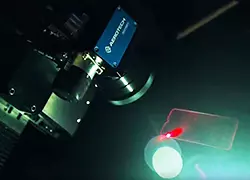1 min read
How Does Laser Processing Work? | Methods, Machines & Material Interaction
How does laser processing work? Laser processing is a sophisticated manufacturing technique that uses a focused beam of light to precisely alter...
Work with our team to determine which products or systems are the best fit for your application.
Some Aerotech products are available for immediate order in North America through our partner Motion Plus.

A case study examining display production that optimizes quality and throughput – and lower total cost.
2 min read
 Bryan Germann
Jun 30, 2025 2:30:46 PM
Bryan Germann
Jun 30, 2025 2:30:46 PM
The widespread adoption of precision laser material processing across countless industries is driven by a clear and compelling set of benefits. This advanced laser processing technology offers capabilities that traditional manufacturing methods often cannot match, providing significant advantages in quality, speed and flexibility. From aerospace and electronics to medical device manufacturing, businesses leverage laser processing to create better products more efficiently.
This advanced laser processing technology offers capabilities that traditional manufacturing methods often cannot match, providing significant advantages in quality, speed and flexibility.
This article will explore the key advantages that make laser-based manufacturing a superior choice for so many applications, including machining, cutting and drilling. Understanding these benefits is the first step in unlocking the potential of this transformative technology.
The laser machining process refers to any manufacturing technique that uses a focused laser beam to selectively remove material from a workpiece. It is a thermal process where the laser's intense energy melts and vaporizes material in a highly localized area. A motion control system then guides the beam along a programmed path to create the desired feature. Breaking down the laser cutting process step by step, it involves focusing the beam, initiating the cut with a pulse of energy and then precisely tracing a path to create the final shape. This non-contact method eliminates tool wear and mechanical stress, making it ideal for creating intricate features with high precision.
When evaluating any technology, it's important to consider both its strengths and weaknesses. In a full review of laser cutting advantages and disadvantages, the benefits are significant and numerous. The primary advantages of laser cutting include:
High Precision and Quality: Lasers create extremely fine, clean cuts with a narrow kerf (cut width) and a smooth edge finish, often eliminating the need for secondary processing.
Design Flexibility: Because the process is software-driven, complex and intricate shapes can be cut as easily as simple ones, with no need for expensive custom tooling.
No Mechanical Contact: This eliminates material deformation and tool wear, ensuring consistent quality and making it ideal for delicate or brittle materials.
Speed: For thin to medium-thickness materials, laser cutting is an exceptionally fast process, leading to high throughput.
The main disadvantage is a limitation on material thickness. For very thick metal plates, other processes like plasma or waterjet cutting may be more effective.
When considering the benefits of laser processing, which of the following is an advantage of laser beam drilling that stands out? A major advantage is its ability to create micro-scale holes with high aspect ratios. Lasers can drill holes with diameters measured in mere micrometers—far smaller than what is possible with conventional mechanical drills.
Furthermore, because the laser removes material through vaporization, it can create very deep holes relative to their diameter (a high aspect ratio). This is critical in applications like drilling thousands of tiny cooling holes in aerospace turbine blades or creating microvias in high-density electronic circuit boards. This capability, combined with incredible speed, allows for the production of features that are fundamental to modern technology but impossible to create with traditional drilling methods.
The most significant, all-encompassing advantage of laser materials processing is its unmatched versatility and flexibility.
A single laser processing machine can be used to perform a wide variety of tasks—including cutting, welding, drilling and marking—across a vast range of materials, from metals and plastics to ceramics and composites. By simply adjusting software parameters like laser power, speed and focus, a manufacturer can switch from cutting thick steel one moment to engraving a delicate polymer the next. This adaptability makes laser processing an ideal solution for rapid prototyping, customized production and high-mix manufacturing environments, providing a level of operational agility that is difficult to achieve with any other technology.
1 min read
How does laser processing work? Laser processing is a sophisticated manufacturing technique that uses a focused beam of light to precisely alter...
What is the most common laser material processing application? Precision laser material processing encompasses a wide array of techniques that have...
What is the manufacturing process of laser cutting? The manufacturing process of laser cutting is a highly advanced method that uses a focused beam...